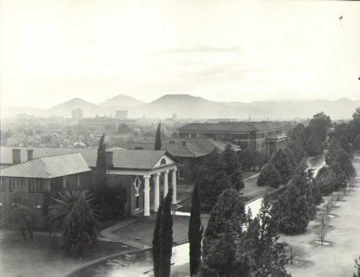
1935. Aerial shot of campus, along South Campus Drive. "A" Mountain is in the distance.
Shantz photo collection
The University of Arizona main campus houses a truly unique collection of plants from arid and semi-arid climates around the world. These trees represent the University's historical dedication to sustainable desert horticulture and tell the story of the cultural evolution of the modern southwest. In the beginning, olive trees and date palms were trialed as potential cash crops and cacti were collected to encourage appreciation and learning about the native desert. By mid-century, growing urbanization and heightened awareness of natural resources, encouraged faculty like Dr. Warren Jones to shift the focus to improving landscape ornamentals. The University of Arizona campus is now the home of hundreds of native and arid-adapted trees and shrub species from every continent on earth. Many campus trees are the largest specimens in Arizona and have been designated as Great Trees of Arizona. Five of these Great Trees have been on the National Register of Big Trees. The Heritage Trees are stately reflections of the University's rich history. Several trees are unique to the Southwest; a few were the first of their kind to be planted in the Western Hemisphere.
In September, 2002, the UA Campus Arboretum was officially dedicated and accepted as a member of the American Public Garden Association with the charge to preserve and enhance this significant collection and to promote stewardship and conservation of urban trees. The main campus, encompassing approximately 400 acres of landscaped spaces, create the boundaries of the Campus Arboretum. In 2005, the Taylor Family Botanical Plaza was formally dedicated in front of the newly refurbished Herring Hall and in 2010 the University of Arizona Campus Arboretum was designated a Tree Campus USA by the National Arbor Day Foundation and Toyota. For a broader description of the goals of the UA Campus Arboretum, please see the Concept Statement.

